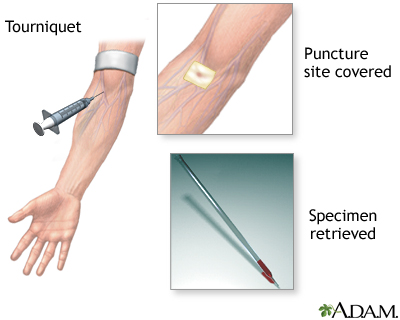
Overview
How the test is performed.
Adult or child:
Blood is drawn from a vein (venipuncture), usually from the inside of the elbow or the back of the hand. The puncture site is cleaned with antiseptic, and a tourniquet (an elastic band) or blood pressure cuff is placed around the upper arm to apply pressure and restrict blood flow through the vein. This causes veins below the tourniquet to distend (fill with blood). A needle is inserted into the vein, and the blood is collected in an air-tight vial or a syringe. During the procedure, the tourniquet is removed to restore circulation. Once the blood has been collected, the needle is removed, and the puncture site is covered to stop any bleeding.
Infant or young child:
The area is cleansed with antiseptic and punctured with a sharp needle or a lancet. The blood may be collected in a pipette (small glass tube), on a slide, onto a test strip, or into a small container. Cotton or a bandage may be applied to the puncture site if there is any continued bleeding.
How to prepare for the test.
Adults:
No special preparation is necessary.
Infants and children:
The physical and psychological preparation you can provide for this or any test or procedure depends on your child's age, interests, previous experience, and level of trust.
For specific information regarding how you can prepare your child, see the following topics as they correspond to your child's age:
- Infant test or procedure preparation (birth to 1 year)
- Toddler test or procedure preparation (1 to 3 years)
- Preschooler test or procedure preparation (3 to 6 years)
- Schoolage test or procedure preparation (6 to 12 years)
- Adolescent test or procedure preparation (12 to 18 years)
How the test will feel:
When the needle is inserted to draw blood, some people feel moderate pain, while others feel only a prick or stinging sensation. Afterward, there may be some throbbing.
What the risks are.
Risks associated with venipuncture are slight:
- Excessive bleeding fainting or feeling lightheaded hematoma (blood accumulating under the skin)
- Infection (a slight risk any time the skin is broken)
- Multiple punctures to locate veins
Veins and arteries vary in size from one patient to another and from one side of the body to the other. Obtaining a blood sample from some people may be more difficult than from others.
Review Date 4/1/2025
Updated by: Warren Brenner, MD, Oncologist, Lynn Cancer Institute, Boca Raton, FL. Review provided by VeriMed Healthcare Network. Also reviewed by David C. Dugdale, MD, Medical Director, Brenda Conaway, Editorial Director, and the A.D.A.M. Editorial team.


